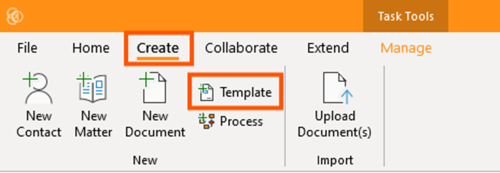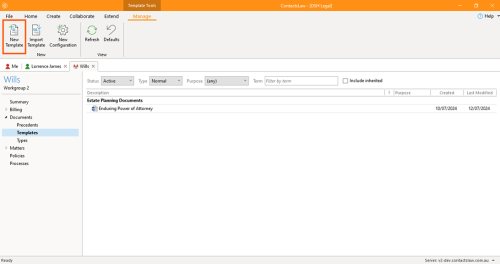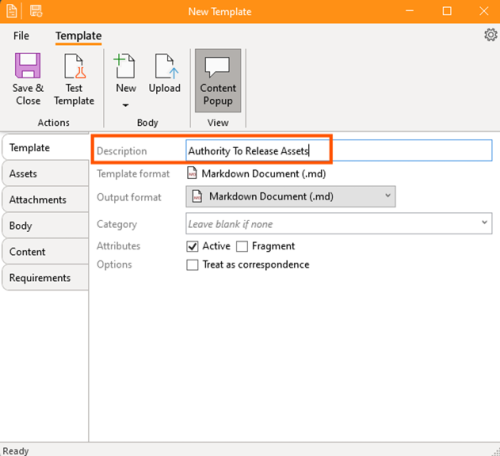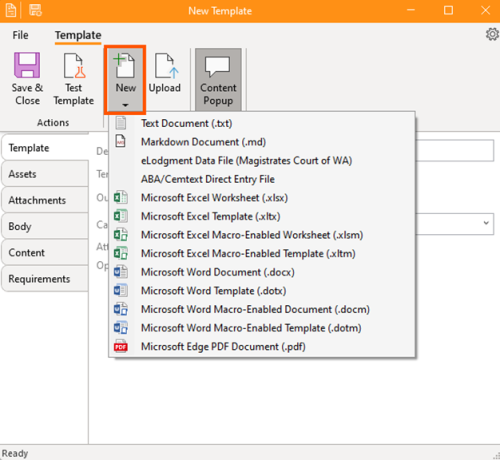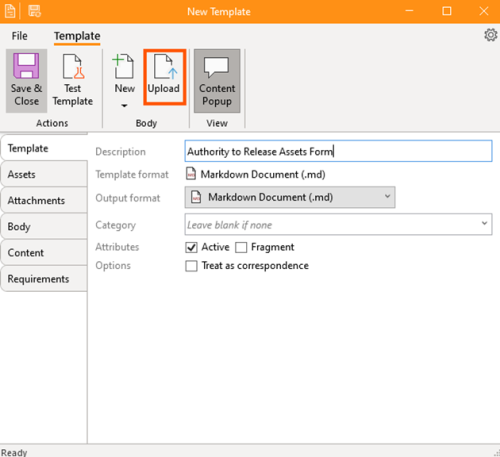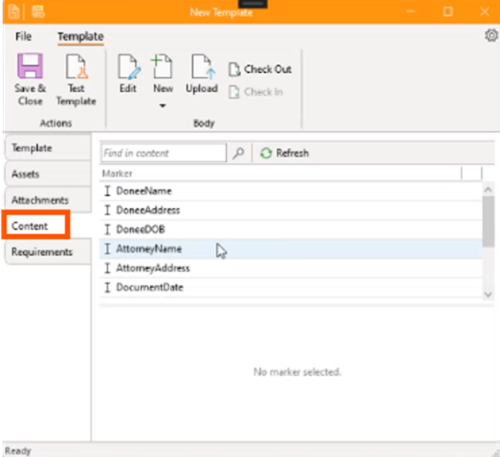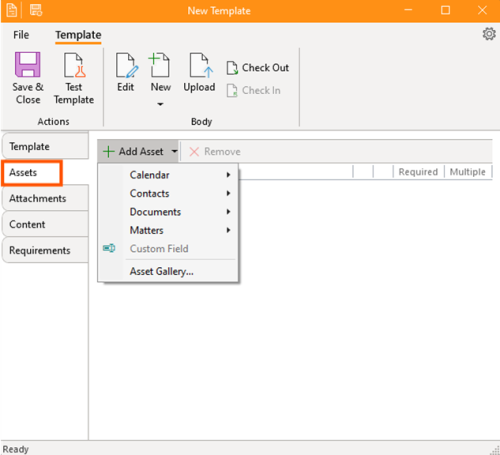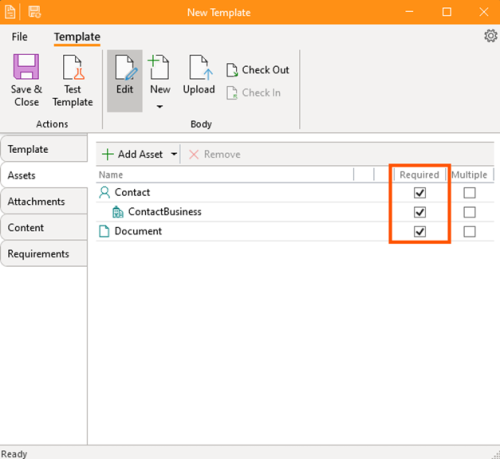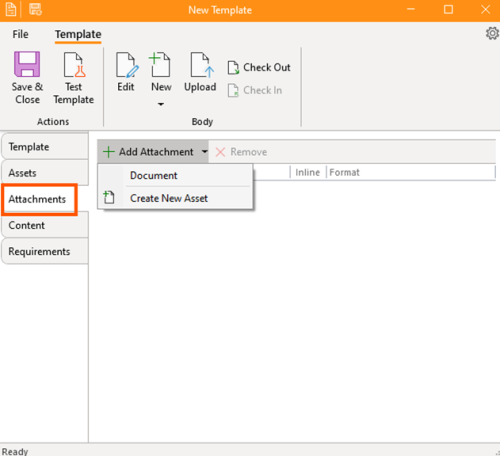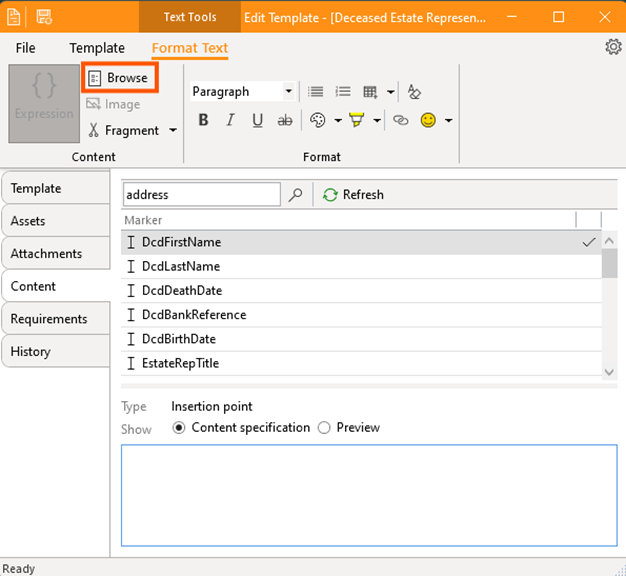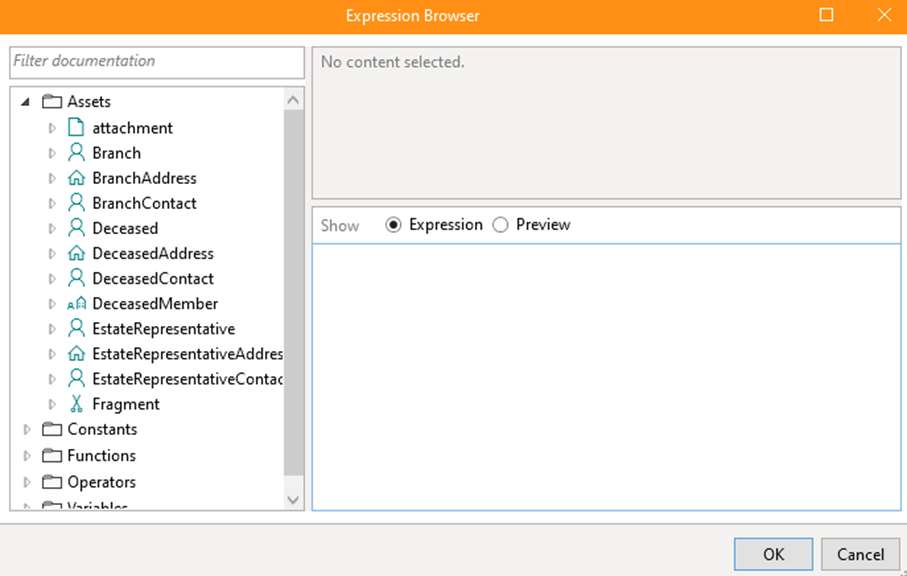How-To:Document Template: Difference between revisions
No edit summary |
m (→9. Final Steps) |
||
| (10 intermediate revisions by 2 users not shown) | |||
| Line 1: | Line 1: | ||
ContactsLaw provides a comprehensive document creation system. | {{DISPLAYTITLE:How to Create Document Templates}} | ||
[[ContactsLaw]] provides a comprehensive document creation system. Its templating functions allow the creation and sharing of powerful templates to reduce data entry and streamline document creation. Users can build and configure their own templates within the system. | |||
The below guide will explain the key steps in creating a template: | |||
== 1. Getting Started == | |||
To open the template editor: | |||
*Option 1: Select the ''Create'' tab on the ribbon and, under ''New'', click ''Template''.[[File:Step 2.3- Create Template.png|none|thumb|500x500px|Creating a template using the "Create" tab on the ribbon.]] | |||
*Option 2: From either a workgroup tab or the subscription tab, select ''Documents'' from the navigation pane and choose the ''Templates'' view. Click ''New Template''.[[File:Step 2.2- Create Template.png|none|thumb|500x500px|Creating a template from the "Templates" view of a workgroup.]] | |||
== 2. Specify Options == | |||
Select your desired options: | |||
*'''Description''' - Enter a name for the template here. | |||
*'''Category''' - This option is for the purpose of grouping similar templates together (e.g. "Correspondence" or "Banking Documents"). | |||
*'''Attributes:''' | |||
**'''Active''' - Selecting this will make the template appear on the list of templates. Unselect this to hide the template from the active template list. | |||
** '''Fragment''' - Fragments are essentially templates that can be included inside other templates, for example, letterheads and signature blocks. | |||
* '''Options:''' | |||
** '''Treat as correspondence''' - Indicates that the template will be used to create correspondence, which is treated specially by the system. | |||
[[File:Create Template - Description.png|none|thumb|500x500px|Naming and specifying options for a template.]] | |||
== 3. Add Template Body == | |||
There are two ways to add the body of the template: | |||
* Option 1: Click the ''New'' button and select a file type to create a new, empty body.[[File:Step 4.1- Create Template.png|none|thumb|500x500px|Creating a new, empty body for the template.]] | |||
* Option 2: Click the ''Upload'' button to use a document from your computer as the basis for your template.[[File:Step 4.2- Create Template.png|none|thumb|500x500px|Uploading an existing document.]] | |||
== 4. Add Content Markers == | |||
The next step is to open the document for editing. Do this by clicking the ''Edit'' button. This will open the document in its associated application; e.g. Microsoft Word (.docx) or Adobe Acrobat (.pdf).[[File:Step 8 - Create Template.png|none|thumb|500x500px|Content markers in a template.]]You need to identify places in the document that will be influenced by data from ContactsLaw. These are collectively known as '''content markers,''' which may be either '''insertion points''' or '''blocks''' (see also: [[Document Template]]). | |||
*'''Microsoft Word (.docx) and most other formats''' - Add content markers using curly brackets (<code>{</code> and <code>}</code>) with an identifying name between them. If you re-use a name, the system will treat all occurrences as one content marker. For example: <code>{ClientFirstName}</code> and <code>{ClientDOB}</code> would be good examples of simple content markers. Note that the name does not itself draw upon data in ContactsLaw; it is merely an identifier for your reference. The connection to the data is made at a later stage. | |||
*'''Adobe Acrobat (.pdf)''' - ContactsLaw creates content markers automatically using the names of form fields in the document. This makes it easy to use existing PDF forms as the basis for a template in the first instance; otherwise, form fields can be easily added to read-only PDFs using Adobe Acrobat. | |||
Once you have finished editing the document, save and close the native editor (Microsoft Word/Acrobat etc). Click the ''Check In'' button on the template editor to check in your changes. | |||
== 5. Identify Assets == | |||
The first step in connecting the content markers to data in ContactsLaw is to identify the '''assets''' you will need. For example, for a bank form to request the release of monies from a deceased person's bank account, you will likely need two [[Contact|contacts]] - one for the Deceased and one for the Executor. You may also need a [[matter]] and addresses. Add any assets you require by clicking the ''Add Asset'' button on the ''Assets'' tab. [[File:Create Template - Asset.png|none|thumb|500x500px|Adding assets to a template.]]You can indicate whether each asset is '''required''' (i.e. mandatory to create a [[document]] from the template) and if it can resolve to '''multiple''' items in ContactsLaw (e.g. is you may want your template to permit multiple Executors, but only one Deceased person).[[File:Step 10 - Create Template.png|none|thumb|500x500px|Setting options for assets.]] | |||
== 6. Define Attachments == | |||
The ''Attachment'' tab allows you to define the '''attachments''' to a template - this is more relevant for emails. Inline attachments are used for images; e.g. [[member]] signatures or the logo for the [[business]].[[File:Step 11 - Create Template.png|none|thumb|500x500px|Adding attachments to a template.]] | |||
== 7. Add Content Specifications == | |||
The ''Content'' tab is where you will connect the content markers in the document to the assets - and ensure the data is formatted the way you want. Click the ''Refresh'' button to update the list of content markers after making changes to the body of the template. You will then write a '''content specification''' for each marker, which may consist of [[Expression|expressions]] and pre-formatted text. | |||
A good starting point for writing expressions is to use the '''expression browser''', which lists all of the components that can make up an expression, along with documentation and example values. Click the ''Browse'' button to open the expression browser. Locate the property of the asset that you wish to insert into the document and either double-click it or select it and click the ''Insert'' button to add it to the expression. You can also apply formatting (see also: [[Document Template]]).[[File:Step 10 - PDF Template.png|none|thumb|626x626px|Accessing the Expression Browser.]][[File:Step 10.1 - PDF Template.png|none|thumb|907x907px|The Expression Browser window.]] | |||
== 8. Add Requirements == | |||
The ''Requirements'' tab allows you to impose restrictions on how the template is used, and to ensure that users are aware of any assumptions or limitations that affect your design. This is optional. | |||
== 9. Final Steps == | |||
You can click the ''Test Template'' button to create a document from the template using generic data. If the document does not generate as you intended, you can return to the editor and make any necessary corrections. | |||
When you are finished, click the ''Save & Close'' button.[[File:Step 12 - Create Template.png|none|thumb|500x500px|Saving and closing the template editor.]]Before you can create documents from the template more generally, you will need to [[Template Configuration|configure]] it for use in a particular workgroup, or from anywhere in your subscription. | |||
[[Category:How-To]] | [[Category:How-To]] | ||
Revision as of 13:27, 3 December 2024
ContactsLaw provides a comprehensive document creation system. Its templating functions allow the creation and sharing of powerful templates to reduce data entry and streamline document creation. Users can build and configure their own templates within the system.
The below guide will explain the key steps in creating a template:
1. Getting Started
To open the template editor:
- Option 1: Select the Create tab on the ribbon and, under New, click Template.
- Option 2: From either a workgroup tab or the subscription tab, select Documents from the navigation pane and choose the Templates view. Click New Template.
2. Specify Options
Select your desired options:
- Description - Enter a name for the template here.
- Category - This option is for the purpose of grouping similar templates together (e.g. "Correspondence" or "Banking Documents").
- Attributes:
- Active - Selecting this will make the template appear on the list of templates. Unselect this to hide the template from the active template list.
- Fragment - Fragments are essentially templates that can be included inside other templates, for example, letterheads and signature blocks.
- Options:
- Treat as correspondence - Indicates that the template will be used to create correspondence, which is treated specially by the system.
3. Add Template Body
There are two ways to add the body of the template:
- Option 1: Click the New button and select a file type to create a new, empty body.
- Option 2: Click the Upload button to use a document from your computer as the basis for your template.
4. Add Content Markers
The next step is to open the document for editing. Do this by clicking the Edit button. This will open the document in its associated application; e.g. Microsoft Word (.docx) or Adobe Acrobat (.pdf).
You need to identify places in the document that will be influenced by data from ContactsLaw. These are collectively known as content markers, which may be either insertion points or blocks (see also: Document Template).
- Microsoft Word (.docx) and most other formats - Add content markers using curly brackets (
{and}) with an identifying name between them. If you re-use a name, the system will treat all occurrences as one content marker. For example:{ClientFirstName}and{ClientDOB}would be good examples of simple content markers. Note that the name does not itself draw upon data in ContactsLaw; it is merely an identifier for your reference. The connection to the data is made at a later stage. - Adobe Acrobat (.pdf) - ContactsLaw creates content markers automatically using the names of form fields in the document. This makes it easy to use existing PDF forms as the basis for a template in the first instance; otherwise, form fields can be easily added to read-only PDFs using Adobe Acrobat.
Once you have finished editing the document, save and close the native editor (Microsoft Word/Acrobat etc). Click the Check In button on the template editor to check in your changes.
5. Identify Assets
The first step in connecting the content markers to data in ContactsLaw is to identify the assets you will need. For example, for a bank form to request the release of monies from a deceased person's bank account, you will likely need two contacts - one for the Deceased and one for the Executor. You may also need a matter and addresses. Add any assets you require by clicking the Add Asset button on the Assets tab.
You can indicate whether each asset is required (i.e. mandatory to create a document from the template) and if it can resolve to multiple items in ContactsLaw (e.g. is you may want your template to permit multiple Executors, but only one Deceased person).
6. Define Attachments
The Attachment tab allows you to define the attachments to a template - this is more relevant for emails. Inline attachments are used for images; e.g. member signatures or the logo for the business.
7. Add Content Specifications
The Content tab is where you will connect the content markers in the document to the assets - and ensure the data is formatted the way you want. Click the Refresh button to update the list of content markers after making changes to the body of the template. You will then write a content specification for each marker, which may consist of expressions and pre-formatted text.
A good starting point for writing expressions is to use the expression browser, which lists all of the components that can make up an expression, along with documentation and example values. Click the Browse button to open the expression browser. Locate the property of the asset that you wish to insert into the document and either double-click it or select it and click the Insert button to add it to the expression. You can also apply formatting (see also: Document Template).
8. Add Requirements
The Requirements tab allows you to impose restrictions on how the template is used, and to ensure that users are aware of any assumptions or limitations that affect your design. This is optional.
9. Final Steps
You can click the Test Template button to create a document from the template using generic data. If the document does not generate as you intended, you can return to the editor and make any necessary corrections.
When you are finished, click the Save & Close button.
Before you can create documents from the template more generally, you will need to configure it for use in a particular workgroup, or from anywhere in your subscription.


